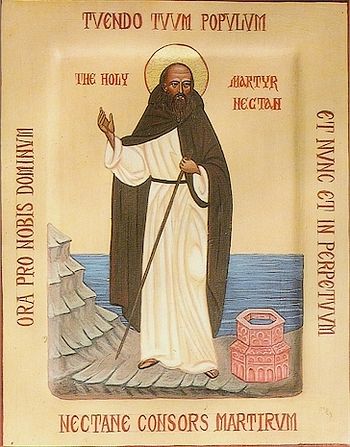
St. Nectan, whose only surviving Life dates back to the 12th century, was born in the second half of the 5th century in Wales. He was most probably the eldest son of the saintly Welsh King Brychan of Brecknock. The latter had many sons and daughters who are venerated as saints and missionaries, and evangelized parts of Wales and Cornwall. One of Nectan’s famous sisters was St. Morwenna who is still remembered by the faithful in the village of Morwenstow in Cornwall. St. Nectan is a saint of the present-day county of Devon in south-western England. The saint’s spiritual labors were carried out precisely in this county which at that time was part of the British kingdom of Dumnonia, stretching to Cornwall and Somerset.
As a young man, Nectan decided to become a monk and serve God for the rest of his life, imitating the Holy Fathers of Egypt, such as Anthony the Great. So together with a group of his pious relatives, Nectan boarded a boat, promising to lead an ascetic life at the site where his boat would land (it would be a sign from above to him). The boat stopped by the north-west coast of Devon at a place called Hartland. It was here that our ascetic settled and began to live a holy life—in the spot called Stoke, which is now a part of the large village of Hartland. (The old English word “stoc’”, or, the modern form “stoke”, means “an outlying farmstead”, “a stockaded place”, “a monastery” or “a cell”. Hence the word “stoke” in parts of many English settlements which had a monastery—such as Basingstoke in Hampshire or Stoke-by-Nayland in Suffolk).
At Hartland the venerable hermit for many years led a strict ascetic life, dwelling in a very dense forest near a spring located on the site of the present-day holy well of St. Nectan. He may have built a tiny hut for himself there in which he offered up fervent prayers day and night. He ate only berries and herbs. For some years absolutely nobody knew of this anchorite. With time relatives of Nectan also moved to live in Devon where they zealously preached the Gospel and converted many pagans to Christ. Nectan for a very long time prayed in his remote, isolated hermitage and the relatives regularly visited him there—exactly once a year at the period of Christmas in order to pray together and thank God for His mercy.
Once Nectan helped a swineherd named Huddon find his stray pigs that had run away. In his gratitude the swineherd gave Nectan two fine cows that provided milk for him. But soon afterwards a band of thieves stole these cows from the saint. However, the venerable hermit on the same day found the robbers and by means of his sermon attempted to convert them to Christ. But the evildoers did not wish to come to believe in Christ; instead, they cut off the saint’s head, and since then he has been venerated as a martyr. According to legend, the beheaded Nectan (to the astonishment of the murderers) took his severed head into his hands and walked towards the spring near which he bore his ascetic labors. Reaching this site, he reposed peacefully (interestingly, the same episode can be met with in the lives of a number of other Celtic martyrs). The tradition holds that this happened in the year 510, and that the saint then was about 42 years old. Seeing this miracle, one of the thieves at once embraced faith in the Savior and buried his body with honor and reverence. As for the rest of the thieves from this band, all of them later either went blind or met a brutal death.
Since that time Nectan has been known and loved in “the West Country” as a martyr and wonderworker. According to tradition, in the places where the innocent blood of Nectan was shed, foxgloves bountifully grew. Many ancient local traditions and stories are associated with Nectan. Thus, it is believed that for some while he lived as a hermit in the present-day village of Trethevy near the northern coast of Cornwall (close to the birthplace of the legendary King Arthur at Tintagel). Another interesting fact is that the Cornish wood called St Nectan’s Glen and the local waterfall are named after this saint. He presumably built a tiny cell above the waterfall where he lived as a recluse for several years in a very idyllic place in the wooded valley near the sea.
A legend relates that Nectan owned a small silver bell installed on the top of a tower there in Cornwall. During the gales, the saint used to ring this bell to prevent ships passing near that rocky valley where they would be wrecked. In Trethevy there are also a chapel and a holy well dedicated to another great Cornish saint—Piran. The village population of Hartland kept the memory that the saint especially hated the sin of ribaldry, so the people tried their best to avoid using foul language. There is a story that in the second half of the 20th century, one teenager did use foul language in the vicinity of this area and nearly died on the same day—only sincere repentance inside the church saved him, and he was healed.
After the martyrdom of Nectan, his relics were placed into a shrine and pilgrims flocked to it throughout the Middle Ages. Early in the 11th century, the church in Hartland received very rich donations, including a splendid new shrine for his relics, and his personal staff was adorned with gold and silver. There is a popular story that in 937 on the eve of the battle of Brunanburgh St. Nectan appeared at night to a young man in Hartland afflicted by the plague that was spreading among the soldiers at that time. The saint touched the young man and healed him completely. The following day the youth appeared before the pious King Athelstan and told him about the miracle, adding that St. Nectan was asking the king to pray to God and the saint during the battle, and then he would be victorious. The king, who had known very little about this saint before, promised to obey—and he won the battle with the saint’s help. And it was not the only miracle—at the same time the plague miraculously passed, and all the soldiers recovered. From that moment on, Athelstan always held St. Nectan in high esteem and became a benefactor of his church.
From the 10th century the land around Hartland was owned by the royal family members related to the Holy King Alfred the Great of Wessex. It was recorded that Countess Gytha (c. 997-1069), mother of the last English King Harold and wife of Earl Godwin of Wessex, founded a church at Stoke (Hartland) in 1050—most likely as a token of gratitude for the miraculous saving of her husband’s life in a storm at sea. In the second half of the 12th century (probably in 1160), on the site of Nectan’s hermitage in Hartland, an Augustinian Catholic Abbey appeared and the hermit’s relics were kept there until the Reformation. Hartland Abbey was the last monastic community closed by Henry VIII in 1539, during the dissolution of the monasteries in England. While the church remained virtually intact, the monastery buildings were either demolished or converted for secular uses. Today what is called “Hartland Abbey” is a country house belonging to the Stucley family, and is often visited by tourists for its furnishings and gardens.
 St. Nectan's Church in Welcombe, Devon
St. Nectan's Church in Welcombe, Devon
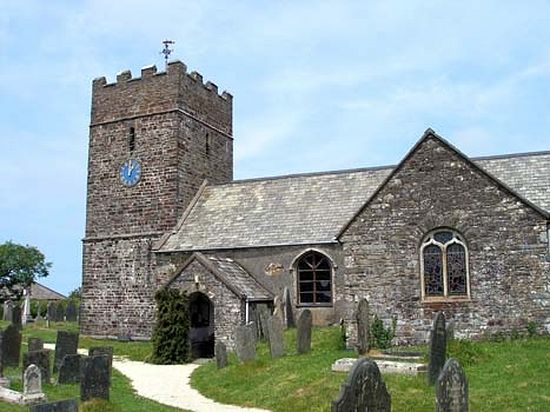 St. Nectan's Church in Welcombe, Devon
St. Nectan's Church in Welcombe, Devon
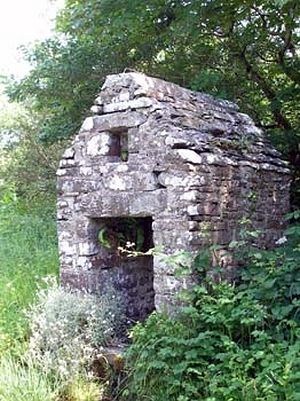 St. Nectan's Well in Welcombe, Devon
St. Nectan's Well in Welcombe, Devon
No fewer than five ancient churches in Devon and Cornwall were dedicated to St. Nectan. Today a medieval church in the village of Welcombe on the Devon-Cornwall border just to the south of Hartland is dedicated to him, and there is St. Nectan’s holy well near the church; this was most likely originally founded by Nectan himself. Remarkably, the curate in this very church for some while was a wonderful English poet, antiquarian, very devout priest and visionary Robert Stephen Hawker (1803-1875), who for many years was rector of Morwenstow church, mentioned above, where he is still remembered and commemorated. Another Devon Church dedicated to this saint can be found in the tiny village of Ashcombe. An ancient church in the village Ashton in Devon situated on the edge of Devon’s Dartmoor national park was formerly dedicated to St. Nectan but its present patron is St. John the Baptist (a perfect match for a patron of hermits). In Cornwall a medieval 13th-15th century church (it is so small that is often referred to as a chapel) in honor of St. Nectan stands near the village of St Winnow. From ancient times this saint was venerated throughout Devon, in parts of Cornwall as well as in such towns and cities as Launceston, Exeter and Wells.
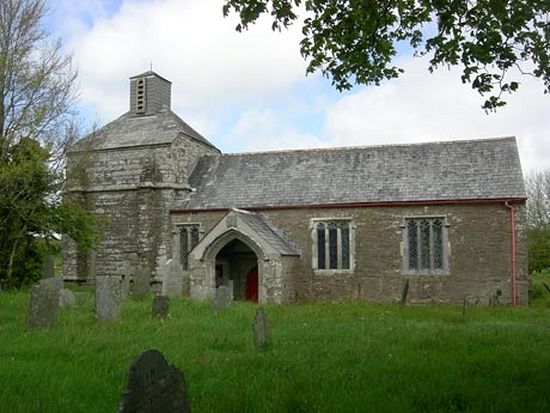 St. Nectan's Church in St Winnow, Cornwall
St. Nectan's Church in St Winnow, Cornwall
But, undoubtedly, the principle center of his veneration always was and still is Hartland in Devon, where miracles occur on the site of this saint’s martyrdom to this day. The saint is the village’s patron. The village is situated on the Hartland Point peninsula near the Bristol Channel, which is referred to as a “sea” in the saint’s life. It is surrounded by very picturesque coastal countryside. The local 14th-century church is dedicated to St. Nectan, and is a destination for pilgrims as it has been for many centuries. It stands a short distance from the center of Hartland in the place called Stoke. This church is one of the finest and longest in Devon (its length is about 137 feet) and its tower, the highest in the whole of Devon, is between 130 and 140 feet high and it can be seen from miles away. This church is a gem and is often called “the cathedral of North Devon”. It is said that the relics of St. Nectan lie beneath the floor to this day. Mary Norton (1903-1992), the children’s writer, best known for her fantasy novels, The Borrowers, is buried in St. Nectan’s churchyard at Hartland.
There is a holy well dedicated to St. Nectan located 100 meters (328 feet) from the church—this spot may correspond with the exact site of the saint’s spiritual labors. There was also a Roman Catholic parish Church of the Mother of God and St. Nectan in Hartland which, unfortunately, closed in 2010. There is an old custom of bringing foxgloves to Nectan’s well on his feast-day, June 17(June 30 OS). (In England there exists an old tradition of decorating, or “dressing” holy springs and wells with flowers and foliage on special church feasts). There are several stones near the well with red stains of the blood of the holy martyr on them—for some locals it is living evidence of the terrible crime and glorious martyrdom that occurred here fifteen centuries ago.1 Also, red streaks of blood can be spotted by the faithful at Nectan’s well. Every year on June 17 Hartland church holds a festal service in honor of the saint with children holding purple foxgloves in participation in the procession round the church (the purple color symbolizes the martyr’s blood). For every pilgrim who comes here, St. Nectan is still indeed present.
Two places in Brittany, France, are named after St. Nectan. Nectan, the holy offspring of the saintly King Brychan, surpassed all his numerous holy brothers and sisters by his God-pleasing life and martyrdom. He is one of a large number of Celtic saints who lived in the 5th-7th centuries—hermits and missionaries—in many districts of southwestern England, Wales, Ireland, Scotland and Brittany.
Holy hermit-martyr Nectan, pray to God for us!
1 Similar evidence can be found in the traditions of veneration of a number of other early English saints. For example, there is a tradition, first verified under the Archbishop of Canterbury in the 12th century, that in the Leicestershire village of Wistow, the hair of the holy martyred Prince Wistan of Mercia (d. c. 850, feast: June 1) grows from the ground every year on his feast day. Another example is connected with holy Virgin-Martyr Arilda of Gloucestershire (6th or 7th century, feast: July 20): water from the holy well which is dedicated to her in a spot between the village of Kington and the town of Thornbury in Gloucestershire is believed to contain her blood; at its outflow this well stains the surrounding stones red.


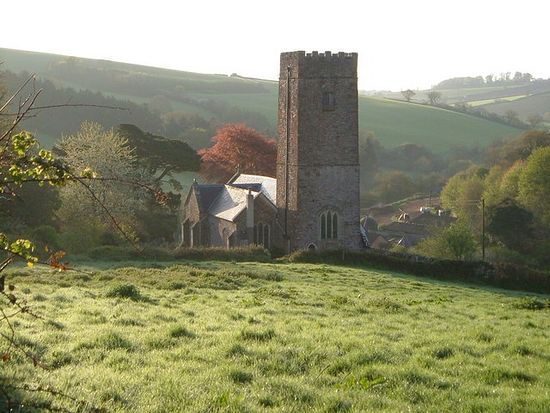
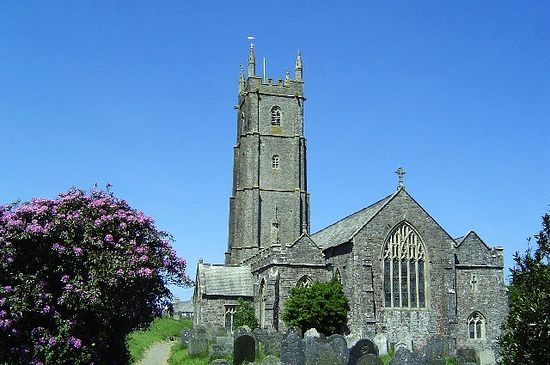
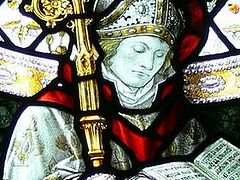
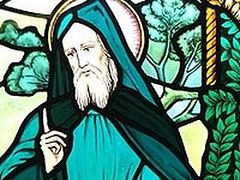
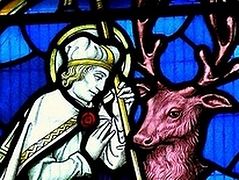
when the time of tribulation comes!